 EDDIE CANTOR (1892-1964)
|
| EDDIE CANTOR (1892-1964) |
American performer, comedian, dancer, singer, actor and composer
Sports & Entertainment
American performer, comedian, dancer, singer, actor and composer with a career that encompassed Broadway, radio, movies and the early days of television. His nickname was "Banjo Eyes" for the eye rolling he did during his song and dance routines. Typewritten letter, dated February 5, 1954, thanking two fans for their recent warm letter. He "Thanks-thanks-thanks" them and signs it "Eddie Cantor."
|
|
 |
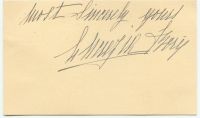 LUCRETIA BORI (1887-1960)
|
| LUCRETIA BORI (1887-1960) |
Spanish lyric soprano
Sports & Entertainment
Spanish lyric soprano, a regular at the Metropolitan Opera House from 1913. Signed card, "Most sincerely yours, Lucretia Bori."
|
|
 |
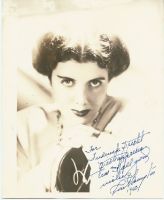 ROSE BAMPTON (1907-2007)
|
| ROSE BAMPTON (1907-2007) |
Leading Operatic Soprano of the Metropolitan Opera beginning in 1932
Sports & Entertainment
Leading Operatic Soprano of the Metropolitan Opera beginning in 1932. Beautiful sepia-tone portrait photograph of Bampton looking directly at the camera in a Diva-like pose. Signed and inscribed on the front, and dated 1950.
|
|
 |
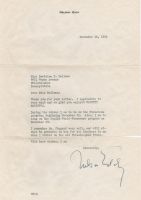 NELSON EDDY
|
| NELSON EDDY |
Stage and movie star
Sports & Entertainment
Stage and movie star, best known for the many operettas he appeared in opposite Jeanette MacDonald. Typed letter on Eddy's personal stationery, dated November 16, 1935, thanking an admirer for kind words concerning his performance in "Naughty Marietta." Boldly signed "Nelson Eddy
|
|
 |
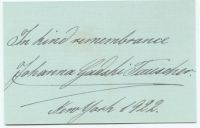 JOHANNA GADSKI (1872-1932)
|
| JOHANNA GADSKI (1872-1932) |
German operatic soprano
Sports & Entertainment
German operatic soprano, admired for her interpretations of Wagnerian roles. Elegant signature and inscription on blue card, "In kind remembrance, Johanna Gadski Tauscher, New York, 1922."
|
|
 |
 MARY GARDEN (1862-1914)
|
| MARY GARDEN (1862-1914) |
Scottish-born operatic soprano
Sports & Entertainment
Large, bold signature on card "Thank you for your letter – With Regards and Greetings! Mary Garden."
|
|
 |
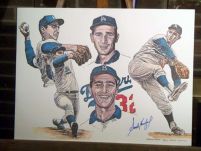 SANDY KOUFAX (1935- )
|
| SANDY KOUFAX (1935- ) |
All-time great Dodgers' lefthanded pitcher
Sports & Entertainment
Baseball pitcher for the Brooklyn/Los Angeles Dodgers, Baseball Hall of Fame and winner of 3 Cy Young Awards in 1963, 1965 and 1966. Koufax was the first major league player to pitch four no-hitters (including the eighth perfect game in the history of baseball.) A limited edition print (18" x 24") boldly autograph signed by Koufax.
|
|
 |
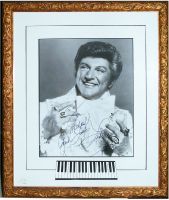 LIBERACE
|
| LIBERACE |
World-renowned pianist
Sports & Entertainment
A world-renowned pianist with a career that spanned four decades and covered concerts, recordings, film and television, Liberace became the highest paid entertainer during the 1950s, 1960s and 1970s.
A child prodigy born to a musical family, Liberace was a showman. He became a star in the '50s, both through his records and assorted television and film appearances. His appearance and repertoire were became increasingly campy, dressing himself in rhinestones, gold lame, furs, and sequins while playing everything from Gershwin and show tunes to lounge jazz and light classical pieces. With a lighted candelabra placed on his piano. Liberace's star rose rapidly in the early '50s, and he had his own syndicated television show, appropriately titled "The Liberace Show." His celebrity reached a peak in the mid-'50s starring in the 1955 film "Sincerely Yours," a movie about a deaf concert pianist, was mentioned in popular song, "Mr. Sandman" by the Chordettes and published his own cookbook. In 1956, Liberace celebrated 25 years in show business with an extravagant concert at the Hollywood Bowl.
Liberace would go on to make appearances on other television programs like "The Ed Sullivan Show, "Person to Person," "The Jack Benny Program," "The Tonight Show with Jack Paar," "Here's Lucy," "The Monkees" and "Batman" among others.
The success of Liberace's syndicated television show drove record sales. By 1954, he had recorded nearly 70 albums with his record "Liberace by Candlelight" selling over 400,000 copies.
This museum quality framed photograph of Liberace measures 13" x 15". The white mat showcases a beautifully cut piano keyboard within the matting at the bottom. The photograph features a personal note reading "To Michael Good Luck, Liberace."
|
|
 |
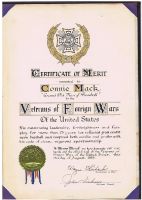 CONNIE MACK (1862-1956)
|
| CONNIE MACK (1862-1956) |
The longest-serving manager in major league baseball history
Sports & Entertainment
American baseball player, manager and team owner and the longest-serving manager in major league baseball history. He played baseball from 1886 to 1896 before becoming manager of the Milwaukee Brewers. He would go on to manage the Philadelphia Athletics for the club's first 50 seasons. He was the first manager to win the World Series three times and the only manager to win consecutive Series on separate occassions (1910-11, 1929-30). Fifty years as a big league manager earned Mack the records for most games managed, most games won, and (of course) most games lost. He finished that amazing career with 3,776 wins, 4,025 losses, and a winning percentage of 0.479. He was elected to the Baseball Hall of Fame in 1937. Born Cornelius McGillicuddy, Mack legally changed his name at the turn of the century so it would fit easier onto ballpark scoreboards.
This Certificate of Merit, dated August 22, 1953, was presented to Connie Mack "Grand Old Man of Baseball" by the Veterans of Foreign Wars of the United States. The document was awarded to Mack for "his outstanding leadership, forthrightness and fair play for more than 75 years has reflected great credit upon baseball and inspired both adults and youths with his code of clean, vigorous sportsmanship." It is signed by Wayne E. Richards, Commander in Chief and Julian Dickenson, Adjutant General. The Certificate was presented to Mack in a presentation portfolio with his name inscribed in gold leaf.
|
|
 |
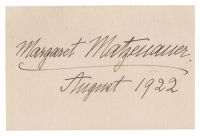 MARGARET MATZENAUER (1881-1963
|
| MARGARET MATZENAUER (1881-1963 |
Margaret Matzenauer (1881-1963) was a Hungarian-born mezzo-soprano singer
Sports & Entertainment
Margaret Matzenauer (1881-1963) was a Hungarian-born mezzo-soprano singer with an opulent timbre and a wide range to her voice. For twenty years, she was with the Metropolitan Opera and performed key Italian and German operas in both Europe and the United States. This card is boldly signed, "Margaret Matzenauer" and dated August 1922.
|
|
 |
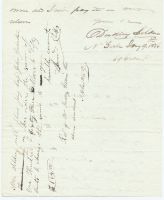 SAMUEL COLT (1814-1962)
|
| SAMUEL COLT (1814-1962) |
Pioneering firearms inventor
Science & Invention
Pioneering firearms inventor, designer of the first practical revolver, which he patented in 1836. Manuscript letter written to Colt by Dudley Seldon offering to pay a bill on Colt's behalf, and suggesting he draw up an order on the reverse of the letter, which Colt has done. On the back of the letter is a pay order written and signed by Colt for $164.50, payable to Captain John Johnston. The letter is dated January 9, 1836, and the pay order is signed "Sam'l Colt." An interesting and unusual Colt item from his early career.
|
|
 |
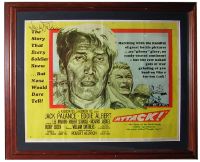 JACK PALANCE (1919-2006)
|
| JACK PALANCE (1919-2006) |
American movie actor
Sports & Entertainment
American actor who entertained stage, screen and television audiences for over 50 years. Prior to his career in entertainment, Palance was a prize winning professional boxer and served as a bomber during World War II for the United States Army Air Forces. Nominated for three Academy Awards, he would eventually in 1991 for the role of "Curly" in "City Slickers." Palance made headlines during his Academy Award acceptance for displaying how physically fit he was by dropping to the floor and performing one-handed push-ups at the age of 73.
Attack! is a 1956 American war film starring Jack Palance, Eddie Albert, Lee Marvin, William Smithers, Robert Strauss, Richard Jaeckel, Buddy Ebsen and Peter van Eyck. It was directed by Robert Aldrich. Described as "A cynical and grim account of war," the film is set in the latter stages of World War II and tells the story of a front line combat unit led by a cowardly captain clearly out of his depth and a tougher subordinate who threatens to do away with him.
This poster measures 33" x 27" framed. It features an illustration of Jack Palance and Eddie Albert surrounded by text that reads, "The Story That Every Soldier Knew...But None Would Dare Tell!" and "Marching with the handful of great battle pictures...no "phony" glory, no candy-coated sentiment-but the raw naked guts of war grinding at you head-on like a ten-ton tank!" The stars and co-stars are printed under the illustration along with a logo for the movie. An additional line of text is printed below the logo that reads,"...the story of the flash-fused, fouled-up company the army called "Fragile Fox"!
Obtained in person by Tom Lingenfelter, president of Heritage Collectors' Society, the poster is copyrighted 1956 and number 56 of 464 that were issued. It is boldly signed in the top left corner, "Jack Palance." Not known for attaching his autograph to many items, this is the only known poster of this movie to have been personally signed by Palance.
|
|
 |
 JACK PALANCE (1919-2006)
|
| JACK PALANCE (1919-2006) |
American movie actor
Sports & Entertainment
American movie actor, bomber pilot during World War Two, won an Academy Word for his role in "City Slickers." Personal check drawn on the Security Pacific National Bank for $273.00, dated March 17, 1986. Filled out in Palance's hand and signed "Jack Palance."
|
|
 |
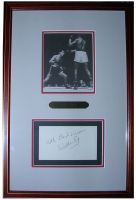 WILLIE PEP (1922-2006)
|
| WILLIE PEP (1922-2006) |
American professional boxer
Sports & Entertainment
American professional boxer who boxed a total of 1956 rounds in the 241 bouts of his 26 year career. His final record was 229-11-1 with 65 fights resulting in knockouts. Pep was considered to be one of the best fighters of the 20th century and inducted into the International Boxing Hall of Fame in 1990. Museum quality frame measuring 11.5" by 17" houses two smaller frames. A photograph of Pep is on top with a signed card in Pep's hand is below. The card reads "With Best Wishes Willie Pep."
|
|
 |
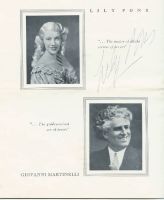 LILY PONS (1898-1976)
|
| LILY PONS (1898-1976) |
French-born operatic soprano
Sports & Entertainment
Debuted at the Met in 1931, and skyrocketed to the highest echelon of opera singers, and was a principal soprano at the Met for the next 30 years. Program for a performance of "Lucia di Lammermoor" at the Mosque Theater in Newark, NJ, on March 28, 1935. Signed by Pons next to her portrait in the program.
|
|
 |
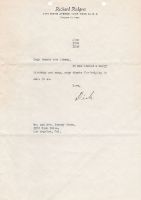 RICHARD RODGERS (1902-1979)
|
| RICHARD RODGERS (1902-1979) |
Broadway composer
Sports & Entertainment
Richard Rodgers was a famous American composer of more than 900 songs and over 40 Broadway musicals such as The Sound of Music, South Pacific, Oklahoma, The King and I and many more. He was the first person to win an Emmy, a Grammy, an Oscar and a Tony. Typewritten and signed letter on Rodgers' personal stationary to songwriter, Johnny Green. Signed affectionately, "Dick."
|
|
 |
 LOWELL THOMAS (1892-1981)
|
| LOWELL THOMAS (1892-1981) |
Explorer, Journalist, Commentator
Sports & Entertainment
His book With Lawrence in Arabia helped propel T. E. Lawrence to fame. 5" by 7" black and white photograph of Thomas wearing a white hat and standing near the tail of an airplane. Signed in red ink, "Lowell Thomas."
|
|
 |
 GENERAL TOM THUMB (1838-1883)
|
| GENERAL TOM THUMB (1838-1883) |
Stage name of Charles S. Stratton, internationally famous “little person” through his work for PT Barnum
Sports & Entertainment
He was married to Livinia Warren in 1863, and received by Abraham Lincoln at the White House afterwards. At the time, he stood 2 feet 9 inches tall. Great carte-de-visite photograph showing Tom Thumb, his wife Livinia, and their friends and fellow Barnum performers "Commodore" Nutt and Minnie Warren
|
|
 |
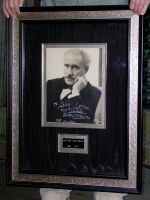 ARTURO TOSCANINI (1867-1957)
|
| ARTURO TOSCANINI (1867-1957) |
One of the most acclaimed musicians of the 20th century
Sports & Entertainment
Toscanini is considered one of the greatest orchestra conductors of all time. He was well known for his intensity, attention to detail and photographic memory. Not one to shy away from his personal beliefs, Toscanini refused to conduct for both Mussolini and Hitler.
Born in Parma, Italy, Toscanini won a scholarship to a local music conservatory where he studied the cello and joined the orchestra of an opera company in 1886. Conflict developed between the company and its conductor resulting in the conductor's firing. It was suggested by the company to have Toscanini pick up the baton and lead them. In spite of his age and lack of training, the public was enthralled with his mastery of the music and his career as a conductor took off. He would gain international fame.
His refusal to display Mussolini's photograph or conduct the Fascist anthem, "Giovinezza," became legendary. Mussolini, incensed at the conductor's refusal to honor him, kept Toscanini under constant watch, tapped his phone and took away his passport. The passport was only returned after worldwide protest. At the outbreak of World War II, Toscanini left Italy for America.
He would flourish during the early days of radio as conductor of the NBC Symphony Orchestra, created especially for him in 1937. Performing live from NBC's Studio 8-H in Rockefeller Center, he conducted his first concert on December 25, 1937. The studio was specifically built for the orchestra complete with perfect acoustics. The NBC concerts continued in Studio 8-H until the fall of 1950 when they would move to Carnegie Hall. The studio would later be remodeled for television and today is home to NBC's long running show, "Saturday Night Live."
This elegant frame is museum quality and displays a photograph of Arturo Toscanini measuring 24" x 30". It houses 2 smaller frames. An 11" x 14" frame of the actual photograph and a 5.5" x 3.5" frame of an engraved plate with Toscanini's name and the years of his birth and death. The photograph was taken in 1938 by famed NBC photographer, Ray Lee Jackson. Written on the photograph in Toscanini's hand, a personal message, "To Lewis Lane, with cordiality, Arturo Toscanini" and date of "May 12, 1941."
|
|
 |
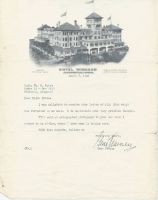 GENE TUNNEY (1898-1978)
|
| GENE TUNNEY (1898-1978) |
American Heavyweight Boxing Champion
Sports & Entertainment
American Heavyweight Boxing Champion, won his title from Jack Dempsey in 1926. He retired undefeated. Typed letter on the stationery of the Hotel Windsor, Jacksonville, Florida, to Major William B. Estes, dated March 7, 1941. Tunney promises to send an autographed picture "in boxing pose." Signed in full, "Gene Tunney."
|
|
 |
 GEORGE EASTMAN (1854-1932)
|
| GEORGE EASTMAN (1854-1932) |
Photographic pioneer
Science & Invention
Photographic pioneer, inventor of the "Kodak," the first hand-held, celluloid film camera in 1888. Signature on paper, "Geo. Eastman."
|
|
 |
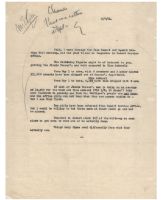 THOMAS A. EDISON (1847-1931)
|
| THOMAS A. EDISON (1847-1931) |
Inventor, businessman
Science & Invention
Thomas Edison (1847-1931) was arguably one of the most influential people in all of history. Credited with "inventing" the Twentieth century and developing the modern research laboratory, he was the most prolific inventor in history with 1,093 U.S. patents in his name as well as patents in the United Kingdom, France and Germany. His numerous inventions included the electric light bulb, the phonograph and the motion picture camera.
Edison owned numerous companies including Thomas A. Edison, Inc, which oversaw his early recordings. The standard of the day was the phonograph and the phonographic wax cylinder. The cylinder was a tube containing up to 2 minutes recorded music. In 1912, Edison introduced the new Blue Amberol Cylinder. More durable than the previous design, these new cylinders could hold up to 4 minutes of recorded music. Edison's company would continue to sell cylinders until they went out of business in 1929.
This typewritten note, dated May 7, 1921, was composed by Charles Edison, son of Thomas Edison, to his father. It discusses the inefficiency of the Blue Amberol division of Edison's company. The content specifically compares employee Jimmie Carson and his team to the team working on Blue Amberol. Charles determines that the Blue Amberol division is not working to its full potential and suggests that the team manages to make itself look busy when necessary. Thomas Edison has written a personal note at the top, "Charles. This is a rotten dept." and includes his prominent initial, "E."
|
|
 |
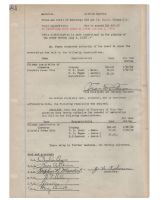 THOMAS A. EDISON
|
| THOMAS A. EDISON |
PART 2 OF MINUTES DOCUMENT
Science & Invention
See Part 1 for description
|
|
 |
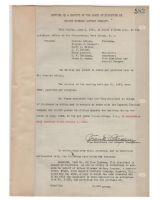 THOMAS A. EDISON (1847-1931)
|
| THOMAS A. EDISON (1847-1931) |
American inventor
Science & Invention
American inventor whose inventions included the phonograph, the motion picture camera, the light bulb among many others. He is the fourth most prolific inventor in history with 1,093 U.S. patents in his name as well as patents in the United Kingdom, France and Germany.
Minutes of a Meeting of the Board of Directors of Edison Storage Battery Company," dated June 5, 1922. Presided over by Mr. Charles Edison, the board authorized the purchase of 16,000 pounds of lithium hydrate. Additional issues discussed were the annual renewal of memberships for in two organizations: Chicago Association of Commerce and the Electric Power Club.
The document was signed by the Board which included "Charles Edison," "Thos A Edison," "Stephen B. Membert," Harry "H.F. Miller," "J. V. Miller," "Henry Lanahan" and Secretary, "J. W. Robinson."
|
|
 |
 THOMAS A. EDISON (1847-1931)
|
| THOMAS A. EDISON (1847-1931) |
American inventor
Science & Invention
American inventor whose inventions included the phonograph, the motion picture camera, the light bulb among many others. He is the fourth most prolific inventor in history with 1,093 U.S. patents in his name as well as patents in the United Kingdom, France and Germany.
United States Post Office receipt dated February 26, 1912 and first received by the Orange, New Jersey post office. Number 10310, the registry notice was presented to Edison on February 27, 2012. A great signature, the document is signed "Thos. A. Edison."
|
|
 |
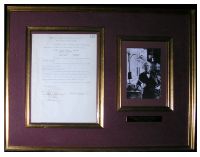 THOMAS A. EDISON (1847-1931)
|
| THOMAS A. EDISON (1847-1931) |
Inventor, businessman
Science & Invention
American inventor whose inventions included the phonograph, the motion picture camera, the light bulb among many others. He is the fourth most prolific inventor in history with 1,093 U.S. patents in his name as well as patents in the United Kingdom, France and Germany.
This museum quality frame measures 24" x 19" houses two smaller frames. The left frame, measuring 8.5" x 12.25," features the typed "Minutes of a Meeting of the Board of Directors of Edison Storage Battery Company," dated February 1, 1921. Presided over by Mr. Charles Edison, the board allotted a portion of the meeting to discuss the "reduction in price of Caustic Soda from Mathieson Alkali Works, Inc." The document was signed by the Board which included "Charles Edison," "Thos A Edison," Harry F. Miller, John V. Miller and Secretary, "Arthur Mudd." The right frame, measuring 7" x 9.5," displays a photography of Thomas Edison.
|
|
 |
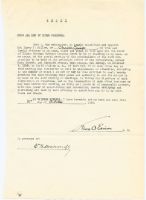 THOMAS A. EDISON (1847-1931)
|
| THOMAS A. EDISON (1847-1931) |
Inventor, businessman
Science & Invention
Invented the phonograph, developed the electric light bulb and the motion picture projector. Typed document of the Edison Storage Battery Company concerning proxy voting. The proxy empowers Edison's son Charles to act on his father's behalf at the annual shareholders' meeting, the first such meeting after the great stock market crash a few weeks earlier. Boldly signed with an especially fine example of Edison's famous "umbrella" signature. Dated October 31, 1929
|
|
 |
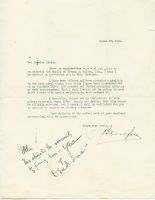 THOMAS A. EDISON (1847-1931)
|
| THOMAS A. EDISON (1847-1931) |
Inventor, businessman.
Science & Invention
Invented the phonograph, developed the electric light bulb and the motion picture projector. Typed letter of resignation from an employee of Thomas A. Edison Inc., dated August 27, 1924, addressed to Charles Edison. Charles has commented and forwarded the letter to his father, writing "T.A.E., This obviates the necessity of firing him." Thomas Edison has added below, "Yes - Dead one. E." An intriguing glimpse inside Edison's pioneer research laboratory.
|
|
 |
 VACLAV HLAVATY (1894-1969)
|
| VACLAV HLAVATY (1894-1969) |
Brilliant Czech-American mathematician
Science & Invention
He wrote extensively about Einstein's Theory of Relatively, and corresponded with Einstein on the subject for many years. Among his notable achievements were solving of several difficult and critical equations related to Einstein's Unified Field Theory. Typed letter on Hlavaty's stationery as president of the Czechoslovak Society of Arts and Sciences in America, dated November 14, 1961, concerning a detailed reply to certain questions relating to relativity, mathematics, and electromagnetic and gravitational fields. Signed by Hlavaty in blue ink.
|
|
 |
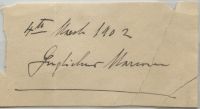 GUGLIELMO MARCONI (1874-1937)
|
| GUGLIELMO MARCONI (1874-1937) |
Italian Physicist and Inventor
Science & Invention
Enormously important in the field of radio, he invented the wireless and formed the first radio communication company, "Marconi's Wireless Telegraph Company." Signature on paper dated March 4, 1902. Clean separation in paper at the "n" and "i" in his last name. A nice strong, early Marconi autograph.
|
|
 |
|

